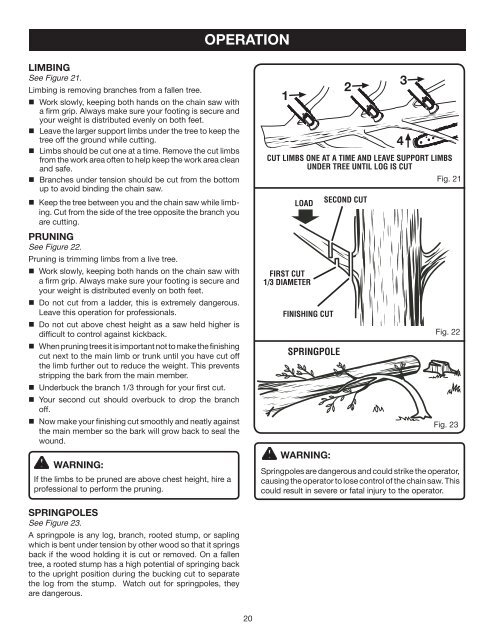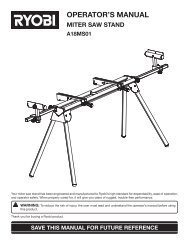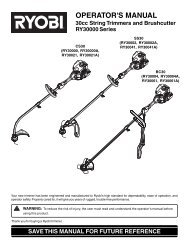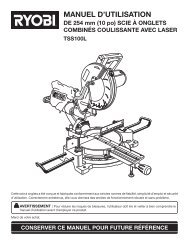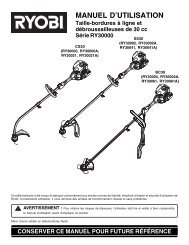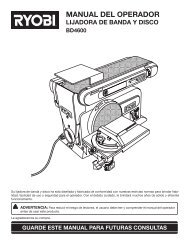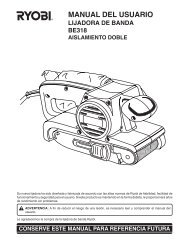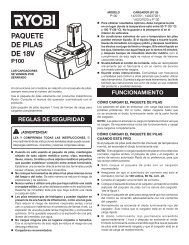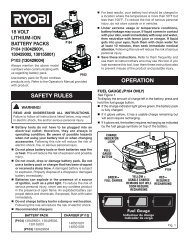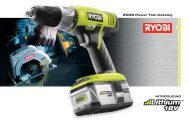OPERATOR'S MANUAL - Ryobi
OPERATOR'S MANUAL - Ryobi
OPERATOR'S MANUAL - Ryobi
You also want an ePaper? Increase the reach of your titles
YUMPU automatically turns print PDFs into web optimized ePapers that Google loves.
LIMBING<br />
See Figure 21.<br />
Limbing is removing branches from a fallen tree.<br />
n Work slowly, keeping both hands on the chain saw with<br />
a firm grip. Always make sure your footing is secure and<br />
your weight is distributed evenly on both feet.<br />
n Leave the larger support limbs under the tree to keep the<br />
tree off the ground while cutting.<br />
n Limbs should be cut one at a time. Remove the cut limbs<br />
from the work area often to help keep the work area clean<br />
and safe.<br />
n Branches under tension should be cut from the bottom<br />
up to avoid binding the chain saw.<br />
n Keep the tree between you and the chain saw while limbing.<br />
Cut from the side of the tree opposite the branch you<br />
are cutting.<br />
PRUNING<br />
See Figure 22.<br />
Pruning is trimming limbs from a live tree.<br />
n Work slowly, keeping both hands on the chain saw with<br />
a firm grip. Always make sure your footing is secure and<br />
your weight is distributed evenly on both feet.<br />
n Do not cut from a ladder, this is extremely dangerous.<br />
Leave this operation for professionals.<br />
n Do not cut above chest height as a saw held higher is<br />
difficult to control against kickback.<br />
n When pruning trees it is important not to make the finishing<br />
cut next to the main limb or trunk until you have cut off<br />
the limb further out to reduce the weight. This prevents<br />
stripping the bark from the main member.<br />
n Underbuck the branch 1/3 through for your first cut.<br />
n Your second cut should overbuck to drop the branch<br />
off.<br />
n Now make your finishing cut smoothly and neatly against<br />
the main member so the bark will grow back to seal the<br />
wound.<br />
WARNING:<br />
If the limbs to be pruned are above chest height, hire a<br />
professional to perform the pruning.<br />
SPRINGPOLES<br />
See Figure 23.<br />
A springpole is any log, branch, rooted stump, or sapling<br />
which is bent under tension by other wood so that it springs<br />
back if the wood holding it is cut or removed. On a fallen<br />
tree, a rooted stump has a high potential of springing back<br />
to the upright position during the bucking cut to separate<br />
the log from the stump. Watch out for springpoles, they<br />
are dangerous.<br />
OPERATION<br />
20<br />
1<br />
LOAD<br />
FIRST CUT<br />
1/3 DIAMETER<br />
FINISHING CUT<br />
SPRINGPOLE<br />
WARNING:<br />
2<br />
SECOND CUT<br />
3<br />
CUT LIMBS ONE AT A TIME AND LEAVE SUPPORT LIMBS<br />
UNDER TREE UNTIL LOG IS CUT<br />
Fig. 21<br />
Fig. 22<br />
Fig. 23<br />
Springpoles are dangerous and could strike the operator,<br />
causing the operator to lose control of the chain saw. This<br />
could result in severe or fatal injury to the operator.<br />
4


